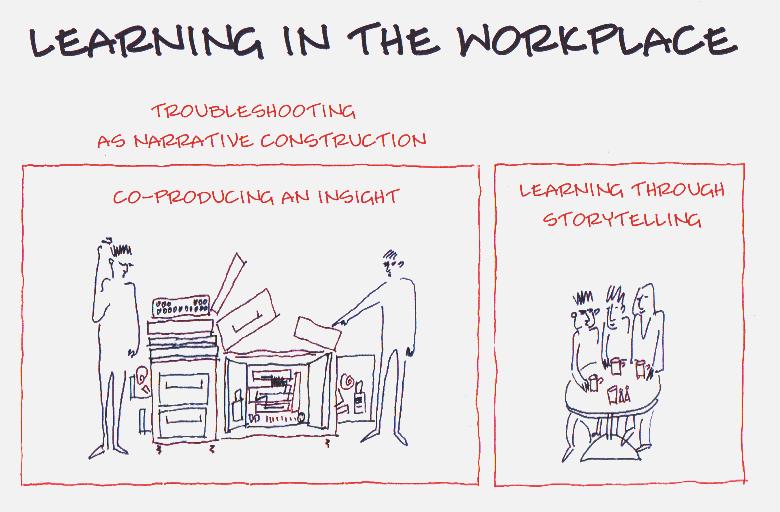Last week the manager of a plant involved in a major organizational change project claimed that the return-on-training of his classroom training courses was disappointingly low. Over the past weeks they have been switching over to SAP, by far the most popular platform in the segment of so-called ERP (Enterprise Resource Planning) software.
We have been preparing the users of his plant by means of extensive classroom trainings, both on process knowledge and systems skills. From his gut feeling he told me that his people demonstrated at best 10 to 15 percent return (i.e.: what they effectively remember and use in their jobs).
Training is the Smallest Part of Learning
I will not argue about the percentages. The point is that I obviously did not create the right expectations: he should be looking for the return-on-learning instead of the return-on-training! On this same blog I already announced the end of teaching and I also proclaimed that teaching is placebo. I even painted a picture about it in order to demonstrate what this means for SAP implementations specifically.
In retrospect the 10 to 15 percent reported by the plant manager is fairly high compared to what I always have been saying: 99% of what ‘Learning’ really is occurs outside of the classroom. The bottom-line is that training alone is not enough in order to make an organizational change happen. Increasing the quality of your training sessions will not leverage the return-on-training to the same extent. At the very best it is a starting point. From there on you will need to coach your way to the future state. The drawing below is taken from John Seely Brown (again!) and clearly depicts how learning really occurs

Now back to the return-on-training question. What could be the best way to increase that return? The answer is simple: this return can only increase if workplace learning has already occurred BEFORE the training session (in action, action through participation, participation with the world, participation with the problem and participation with other people, i.e., practices). Involvement, participation and ownership are key.
Time-to-Task
The concept of Time-to-task is another way to look at it. Normally we use that term to describe that the training should occur as closely as possible to the task at hand. The only way return-on-training can increase is when time-to-task is negative. In plain English this means: people will get more out of a classroom training when they have been frustrated by real-life problems form the task at hand; they will posses an enormous learning pull and they will ask for and absorb every detail that is needed for the job at hand.
Here is a quote from David Maister to support that view:
A good test for the timing of training would be as follows. If the training was entirely optional and elective, and only available in a remote village accessible only by a mule, but people still came to the training because they were saying to themselves, “I have got to learn this – it’s going to be critical for my future,” then, and ONLY then, you will know you have timed your training well. Anything less than that, and you are doing the training too soon.
Rethinking Knowledge Management
Participation, involvement and enculturation (i.e.: “belonging to”) lies at the heart of learning. It also lies at the heart of knowing. Knowing has as much to do with picking up the genres of that particular sub-profession as it does with its conceptual framework. For example, how do you recognize whether a problem is an important problem, or a solution an elegant solution, or even what constitutes a solution in the first place?
Jerome Bruner made a brilliant observation some time ago when he said that we can teach people about a subject matter, for example, physics. That is, we can teach them the concepts, conceptual frameworks and facts of physics – the explicit knowledge of physics. But that does not make the student a physicist. To be a physicist he must also learn the practices of this profession. As he continues:
“We teach a subject not to produce little living libraries on that subject, but rather to get a student to think mathematically for himself, to consider matters as an historian does, to take part in the process of knowledge-getting.”
Here we are. Now what?
All the evidence tells us that learning is a social thing. It exists in action, participation with the world, participation with the problem and participation with other people, i.e., practices. A lot of the knowledge comes into being through the practices of the people and the environment you’re working in. The return-on-learning question reveals the challenge we face today for rethinking knowledge management:
- Shift our mindset from “pushing knowledge to people” (authority based and explicit) to “supporting people to participate in their productive inquiry” (situational based and on-the-fly)
- Shift from tools to increase the individual knowledge stock to tools which support relationships and interaction.
- Shift rigid structures from managing an academy (where knowledge gathers dust) to facilitating an ecology of different communities-of-practice (where knowledge lives and evolves).
- Do everything we possibly can in order to introduce Web 2.0 thinking in the boardroom. Think: collaboration and moments of truth instead of teaching!
Talking about organizational change management… there is work to do!



Pingback: Luc’s Thoughts on Organizational Change » Blog Archive » Less Training, more Learning!()
Pingback: Return-on-Training? Wrong Question! | Reply-MC | Using Brain Power in Business | Scoop.it()